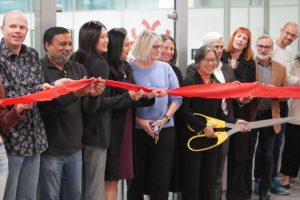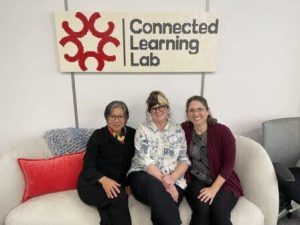Ribbon-Cutting Ceremony Marks Milestones for the Connected Learning Lab
March 24, 2025

The ribbon cutting ceremony included (from left) Andre van der Hoek (Associate Dean for Academic Affairs, ICS), Madhu Reddy (Associate Dean for Graduate Programs, ICS), Jill Kay (Director of Research Policy, Office of the Vice Chancellor for Research), Frances Contreras (Dean, School of Education), Heike Rau (Assistant Dean, ICS), Kylie Peppler (Professor, Informatics and Education), Mimi Ito (Professor, Informatics and CLL Director), Errol Arkilic (UCI Chief Innovation Officer), Katie Salen Tekinbaș (Professor, Informatics), Bill Maurer (Dean, Social Sciences) and Stephen Schueller (Professor, Social Ecology).
Last week, a ribbon-cutting ceremony and luncheon celebrated two long-awaited milestones for UC Irvine’s Connected Learning Lab (CLL): approval as a full Organized Research Unit (ORU) and completion of a new 1250 square-foot collaborative workspace in the CALIT2 Building.
The CLL is a community with more than 40 affiliated faculty spanning seven schools at UC Irvine. The CLL faculty are dedicated to wellbeing and progressive approaches to education that are equity-oriented, learner-driven, and supported by digital technologies, including AI, extended reality (XR), and networked games and media.
“It is a challenging time to be elevating a new research institute focused on education and equity, but at the same time, it’s more important than ever that we stay invested in this area of research,” said CLL Director Mimi Ito during introductory remarks. Welcoming faculty, staff and students to the CALIT2 auditorium, Ito shared some history about the CLL and its vision for the future before moving the crowd upstairs for the ribbon-cutting ceremony.
Building on Decades of Work in Digital Media and Learning
The CLL journey started in 2004 with a series of investments to UC Irvine from the MacArthur Foundation, eventually totaling $40M. These investments supported the Connected Learning Research Network and the Digital Media and Learning (DML) Hub, as well as the DML Competition, offering seed grants to innovators. Ito was involved from the start, and over the next 15 years, she helped recruit faculty with expertise in digital learning, including Katie Salen Tekinbaș and Kylie Peppler (who lead the CLL with Ito), as well as Shayan Doroudi, Nia Nixon, Constance Steinkuehler and Kurt Squire.
“We really have an amazing group of faculty, not just the folks who were part of the MacArthur DML initiative, but the campus itself has a huge amount of expertise in these areas,” said Ito, referring to interdisciplinary research on supporting healthy communities and joyful learning in a networked and digital world. Building on these strengths, the CLL was founded in 2016 as a center in the Donald Bren School of Information and Computer Sciences (ICS). A few years later, in 2019, the Office of Research approved the CLL as a Provisional ORU — an academic unit that aims to provide a supportive infrastructure for interdisciplinary research.
With faculty from anthropology, comparative literature, computer science, education, English, informatics, nursing, psychological sciences, and sociology, there is no question that CLL research is interdisciplinary. Furthermore, with digital media and education touching so many aspects of daily life, CLL work is in areas of high impact and public concern. The CLL often focuses on learning spaces outside of the traditional classroom — at libraries, after-school programs, and student clubs — so the research also leads to unique partnerships.
“We moved to a model where we’re more of a hub for collaboration, for connection, for external communication,” said Ito, explaining that the structure differs from a traditional ORU in that the CLL is more decentralized and reliant on external visibility and engagement. The CLL doesn’t just bring people together to foster conversations; it develops capacity among faculty and students to communicate their work to external audiences.
“What CLL is working on is the kind of society-facing assessment of information technology that we’re going to need a lot more of in the coming years,” says Errol Arkilic, Chief Innovation Officer, UC Irvine.
Since the CLL was established as a provisional ORU, CLL faculty have brought in almost $40M in funding, and not just federal funding. “That’s the unique characteristic of our research area and our publicly engaged faculty,” said Ito. “We have funding from a diverse range of private foundations and donors.”
Fostering Community in a Digital World

The Connected Learning Lab (from left): Director Mimi Ito, Managing Editor Jenna Abrams and Head of Operations Julie Herrick.
The CLL transitioned from “provisional” to “full” ORU in January 2025, and with this new status, it’s revamping its mission statement. The aim is to highlight how the CLL fosters connections across not only disciplines but also culture and sectors of society, supporting healthy youth development and thriving communities in today’s digital world. Bringing social and cultural considerations to technology design, CLL faculty have strengths in everything from digital youth culture to emerging technology, including generative AI.
“What we’ll be showing you in a few minutes is the new collaborative space, which has been a long time coming,” said Ito, wrapping up her introduction. “We’re continuing to have… dialogue sessions for faculty and students to share work in progress.” CLL faculty have been running a series of dialogues around “AI and learning,” and they plan to start a new series around “neurodiversity and connected learning.”
“We’re always open for people who want to organize new topics or events [as] we enter our first year as a full ORU,” said Ito, inviting the crowd to join her upstairs to view the new space for forward-looking collaboration. With everyone lining up just outside the Connected Learning Lab on the fourth floor of Calit2, collectively holding the outstretched red ribbon, Ito sliced through with oversized scissors, marking the next phase of the CLL journey.
“I’ve been delighted to see the growth of the CLL,” says ICS Dean Marios Papaefthymiou. “It has transitioned from an ICS center to a full ORU that connects our school’s expertise in computing with colleagues across campus working in education, health, and youth development.”
Contact the CLL to subscribe to its monthly newsletter to learn about working groups, interdisciplinary training opportunities, and events, including the annual Connected Learning Summit. You can also visit the Connected Learning Alliance, which publishes essays and reports from the CLL community.
— Shani Murray
